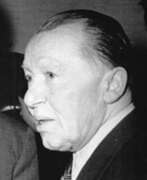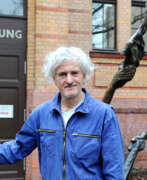German Democratic Republic Contemporary art


Lea Grundig was a German twentieth-century artist of Jewish descent. She is known as a graphic artist, illustrator, teacher, and professor at the World School of Fine Arts in Dresden.
Grundig addressed political and social themes in her graphic series created in Germany, including works devoted to exposing the Nazi regime. In 1936, the artist was arrested by the Nazis and her work was declared "degenerate art."
Grundig was president of the GDR Artists' Union. In 1972, she organized the Hans and Lea Grundig Foundation to support the cultural, pedagogical and artistic achievements of students and graduates of the Kaspar-David Friedrich Institute at the University of Greifswald.


Hans Grundig was a German artist of the first half of the twentieth century. He is known as a painter, graphic artist and teacher, professor and rector of the High School of Fine Arts in Dresden, and husband of the artist Lea Grundig.
Grundig produced works that stylistically belong to the "new materiality" and revolutionary-proletarian realism. In 1932 he visited the USSR, where he participated in the exhibition "Revolutionary Art in Capitalist Countries" in Moscow. His art during this period was strongly anti-fascist, the works were created in a realistic-expressive style. After the Nazis came to power, he was banned from painting and his works were recognized as "degenerate art". The artist was arrested and sent to the Sachsenhausen concentration camp.
Grundig's paintings today are an important part of the golden fund of realist art in twentieth-century Germany.




Sergey Yakovlevich Lagutin (Russian: Сергей Яковлевич Лагутин) was a Soviet and Russian artist of the second half of the twentieth and early twenty-first centuries. He is known as a painter, scenographer, teacher and art theorist.
Sergey Lagutin began his career in 1934 while serving in the army, where he first participated in an exhibition of military artists. Throughout his career, the artist designed theatrical performances and worked in theaters in East Germany and the USSR. His contributions to the field of art include the development of the program and methodology for teaching composition adopted in all art schools in Russia.


Max Lingner was a German artist of the first half of the twentieth century. He is known as a painter, graphic artist, muralist and teacher.
Max Lingner at the beginning of his career, studying in Paris, was influenced by Impressionism. He worked as a painter and engraver for the newspaper Le Monde. Joining the French Communist Party, Lingner fought on the Republican side during the Spanish Civil War and fought against the Nazis in the Resistance Movement in France. After returning to the GDR, he became a professor and created the monumental panel "Building the Republic" in the House of Ministers. The artist donated the 40 paintings, prints and watercolors he had brought back to the state.


Otto Nagel was a German artist of the first third of the twentieth century. He is known as a painter and graphic artist, one of the most famous artists of the GDR.
Otto Nagel's work focused on depicting Berlin through portraits, life scenes and cityscapes. He was an important figure in the German art scene. In 1933 he was elected chairman of the All-German Artists' Association, but this association was soon dissolved by the Nazis who came to power.
Nagel was president of the GDR Academy of Art. His name is immortalized in the names of streets and institutions in Germany.


Wolfgang Opitz is a contemporary German artist known for his abstract paintings.
Wolfgang Opitz studied art from 1964 to 1968 in Erfurt and Dresden. He met A. R. Penck, with whom he made many experimental films in 1969. They also founded the group Lücke in 1971, together with artists Harald Gallasch and Steffen Koonert (Turk). In 1989, Opitz fled East Germany to the West, where he received a teaching position at Lüneburg University in 1991.

















































